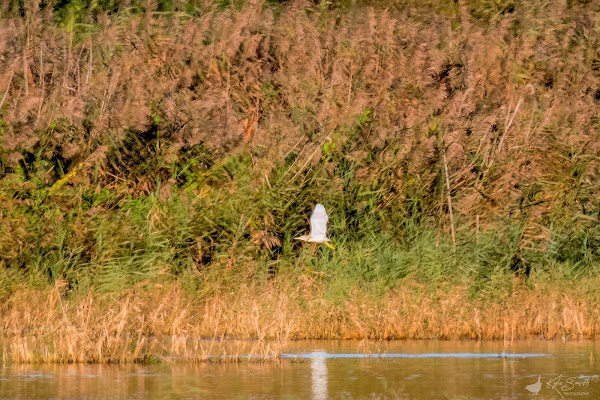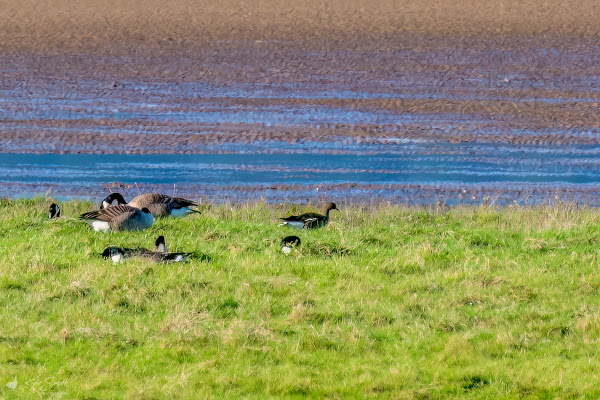Kev @kev07713 and I hadn't been able to touch base on Friday evening and so the final decision where to go was made as I collected Kev from home on Saturday morning. The barred warbler had not been reported at all at WWT Slimbridge on Friday and so we agreed to visit RSPB Ham Wall and add a squacco heron to my year list - Kev and his wife Karen @karenheath62had already seen one back in May. We stopped on the way for breakfast and contacted Kev's sister Karen @hobbylovinglife to tell her where we were going, only to find she planned to do the same.
We arrived in the lane along Long Drove just off the main RSPB Ham Wall Reserve and found a handful of birders in place with scopes looking for the squacco heron. We parked by another car, short of where the birders were standing, and jumped out to put on our walking boots - our shoes were muddy by the time we got to the back of the car and we'd not be able to put these back on to get back into the car without getting very dirty mats. I have standards you know.
We joined the others to hear that the bird had not yet shown so we began scanning at the back lefthand water's edge as this is reportedly where it favoured. A couple of kingfishers sped around the area we were watching but too far even for a record shot. Overhead and down either side of the pool both male and female marsh harriers quartered singly and in pairs, the females showing strong contrast between their cream crowns and their dark body and wings.
In the trees behind, Kev picked up calls from lesser redpoll and lead the search, eventually picking out an individual - I stayed behind and kept a lookout for the squacco. In the trees to our right two and three cormorants perched high, wings extended and at the end of the pool a solitary grey heron stood as still as a statue.
The squacco favours freshwater marshes, lakes, and ponds with reeds and other surrounding vegetation - this habitat looked perfect. It is a rare vagrant in Britain and out of the breeding season is mostly solitary, wintering in Africa.
A flock of cattle egrets appeared in the sky and made their way from right to left, three breaking away. We watched as most dropped into a field of cows but scanning back, we saw a white bird spin in the air and drop into the trees we'd been watching. A quick look through bins and we could see it was our squacco heron - it burrowed deeper into the foliage and only partly in view.
After ten minutes or so it climbed onto the branches and into view but very distant, then dropped into the water and fished, catching a couple of fish. In just a few minutes it took to the wing and flew across the far end of the pool, landed briefly in the water and partly obscured by reeds, and then lifted up and disappeared into a bush on our righthand side. Although it briefly showed again on the lefthand edge, this was to be the best views we'd have - how it got from right to left without us seeing it is beyond me.
Soon Kev's sister Karen @hobbylovinglife and her partner Dean @worlebirder arrived to have a look for the heron. We chatted for a while as this is the first time I've caught up with Karen since her treatment - so good to see her now on the road to recovery. There was a cold breeze, and we hoped the heron would show again soon, but it didn't - we watched cattle egret, bittern, and cormorants on the water and in the trees. Eventually we discussed what to do next and after checking out Birdguides agreed to make our way back up the M5 and drop into WWT Slimbridge - a barred warbler had been reported earlier in the morning, as had a lesser white-fronted goose - both would be lifers for me.
We had a smooth journey up and were soon at the Estuary Tower hide, making our way to the top to get the best panoramic view, and be able to look down into the trees and hedges where the barred warbler had showed. There were a good number of birders here, out in the open and against the glass barriers. One helpful chap gave us a steer as to where the lesser white-front goose was - as you'd expect very distant and sat down out of view, even from this elevated vantage point. When it did appear it displayed no bling (rings), this is the reportedly most endangered breeding goose species in Europe. However, there had been the highest number fledged youngsters noted in the Norwegian population since monitoring began in 1990 - perhaps the real deal?
Rain hadn't been forecast but it came down anyway, sending us all running for cover - quite a downpour. While we were standing at the top of the stairs a voice introduced themselves to Kev - it was Nicola Benhamada - Kev and his wife Karen had met her in Birmingham last year when searching for a wryneck - we are all connected on X (formerly known as Twitter). We had a chat while we waited for the rain to stop and when it did, we couldn't find the lesser w-f goose at all. The long-staying Ross's goose did put in an appearance, as did a greater white-fronted goose, and a rogue bar-headed goose.
A chap from the lower level popped onto the platform and said that someone had spotted a short-eared owl off to our right. We all scanned to see if we could pick it up and sure enough five minutes later it flew along the edge of the path, landing on a post but frustratingly mostly out of view from where I was stood.
The owl must have been exhausted as it was allowing people on the path to come close and video on their phones, notably a woman on her mobility scooter! Despite this, the owl was flushed again and hopped across the hedge and onto a post … more in view. Several people could be seen poking their cameras through the hedge and were presumably getting breath-taking views. It didn't take too long before the owl gathered the strength to take to the wing and fly off and away from our position.
Shortly after Shaun Evans @sevans1032 and Chris Macey @chrismacey57 joined us on the platform - they'd been on the path when the short-eared owl dropped onto the post and had taken some jaw-dropping photos - follow the links by their names to see some special images. They had hoped to see the barred warbler, but it looked like we were all going to leave disappointed - maybe not a surprise with the number of people milling around ...
Out in front two planes appeared and passed overhead, Rockwell B-1 Lancer (Bone) strategic variable-wing bombers serving in the U.S. Air Force fleet. It is a platform that combines the Mach 2 speed of the B-58 Hustler with the range and payload of a B-52 and was meant to ultimately replace both. Not often seen in the UK, it was good to see them in the sky.
We were working out if we should make tracks when a call went up and a ringtail hen harrier passed behind the hide, being mobbed by crows. None of us were prepared but I shot off a few photos to try and capture the moment. The sun was out and glaring directly on the harrier’s head making it tricky to get any quality - what might have been ... prep and warning, but that doesn't often happen in the field.
We waited as long as we could, hoping that the barred warbler would appear, but it wouldn't. The wait for one of these goes on.






















No comments:
Post a Comment